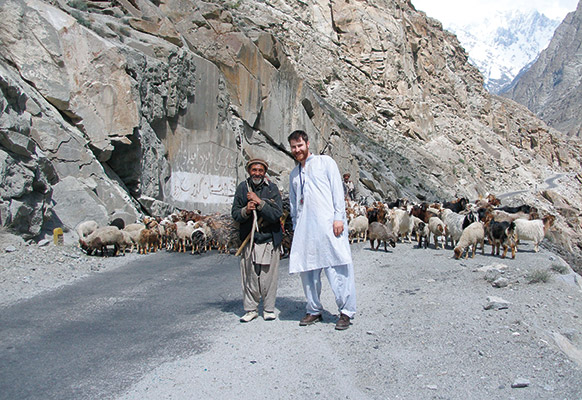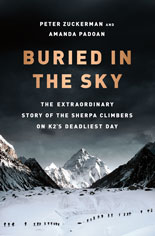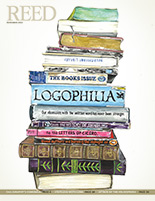
IRIS login | Reed College home Volume 91, No. 4: December 2012
The Books Issue
Snowbound

Peter Zuckerman ’03 and the sherpas who survived K2.
by Romel Hernandez

Peter Zuckerman ’03 and Amanda Padoan
Buried in the Sky: The Extraordinary Story of the Sherpa Climbers on K2’s Deadliest Day
W. W. Norton & Co., 2012
He trekked for hundreds of miles on treacherous mountain passes and switchbacks through Nepal and Pakistan, where he ran the risk of running into Maoist or Taliban insurgents.
He took another sort of trip after eating a psychedelic Himalayan caterpillar mushroom that made his travel companions so sick they had to be airlifted to the nearest hospital by helicopter.
And, as he held on for dear life aboard the Soviet-era chopper lurching over the mountains toward Kathmandu, Peter Zuckerman could have been forgiven for quitting the whole book thing right there and then.
But no. “I felt really good, actually,” he remembers. “I’d been uncertain about whether this crazy project was going to work out up to that point, and now I had a strange sense of purpose . . . I was going all out on this book; I was going to make it happen.”
Buried in the Sky, the recent bestseller coauthored by Peter and his cousin, Amanda Padoan, tells the breathtaking story of a mountaineering disaster on K2, the world’s second highest peak, that claimed 11 lives in August 2008. The Wall Street Journal praised the book’s “phenomenal research and vivid writing” and Men’s Journal called it a “a narrative that is hair-raising and moving, but also precise.” The book also won a prestigious Orwell Award, given by the National Council of Teachers of English.
The authors anchor their account on two Sherpas—Chhiring Dorje Sherpa and Pasang Lama—who played critical roles in the drama. Historically, Sherpas, the Nepalese people renowned as mountaineering guides, have been relegated to the background in books about the epic exploits of great climbers. Peter felt it was vital to center his book around these unsung heroes, who rose up from poverty and hardship in remote villages to the top of the world—literally.
“When your life hangs from a knot, you need to know who tied it—your life may depend on it,” he says. “Sherpas are the ones who establish the camps, scout the routes, set the ropes, escort the clients to the summit and take the photo that runs in the newspapers.”
Known by locals as Chogori, meaning “doorway to heaven,” K2 is referred to by climbers as “the savage mountain.” The book explains why that name is so fitting: “K2’s glaciers are riddled with fissures concealed by layers of snow; climbers step on these crevasses, punch through, and, if unroped, disappear. Blocks of ice cleave off overhanging glaciers; avalanches roar down icy flanks. And then there’s the altitude. No human, plant, or animal can tolerate such harsh conditions for more than a few days.”
Yet adventurers from across the globe vie every year to climb K2, which straddles Pakistan and China. Some 300 have reached the peak, compared to 3,000 for Everest. On the fateful climb recounted in Buried in the Sky, alpinists from across the world were scrambling for the summit, with the support of dozens of Sherpas. The authors do an outstanding job of braiding together the strands of the complex story and its characters, while providing just the right amount of historical and cultural context for nonaficionados.
Peter himself has traveled a fascinating path. Growing up in Southern California, he was teased for having a learning disability and for being gay (at the time he was struggling with his sexual orientation). At Reed he thrived. He majored in biology and edited the Quest. He still recalls many of the articles he published, including a controversial piece about student tattoos. Along the way, he interned for Just Out (a local gay and lesbian paper) and the Associated Press.
In many ways, Reed’s rigors, particularly his thesis on piscine sex (“Female Sexual Ornaments and Operational Sex Ratio in Pelvicachromis pulcher”), prepared him for the challenges he has faced in his career.
“Doing a hardcore thesis really prepared me well for doing difficult, very deeply researched projects,” he says. “I remember my thesis adviser telling me, if I didn’t know something, ‘You need to find this out. You don’t get to skip over this or do a half-assed job.’”
After Reed, he got a journalism fellowship with the Poynter Institute and a job as a reporter for the Idaho Falls Post Register. It was there that he followed up a confidential tip that led to a series of investigative articles exposing child molestation cases involving the Boy Scouts. He was relentless in reporting the story, despite the controversy that erupted and the personal attacks against him that ensued. The “Scouts’ Honor” series earned him several journalism honors, including the Livingston Award. His efforts to uncover the story were also the subject of an Emmy-winning documentary on PBS.
Peter returned to Portland in 2007 to take a reporting job at the Oregonian. A couple of years later, he received a call from his cousin. A lawyer in California and avid mountain climber, she had known one of the men killed on K2. She had an idea for a book, but she was also nursing a newborn. She needed a collaborator, and Peter was the obvious candidate.
“I had no choice,” he writes in the introduction to Buried in the Sky, “but to quit my job, grab a notebook, and head to the Himalaya. The characters were too inspiring, the goal too important, and the journey too compelling to resist.”
Although he had never climbed a mountain (and still hasn’t), Peter undertook his own two-year odyssey, traveling numerous times to the region and spending nearly six months doing research in Nepal and Pakistan. Tracking down key figures in remote villages was neither simple nor safe. To begin with, Sherpa naming conventions are such that thousands of people share the same name. And once he tracked the subjects down, conducting interviews through interpreters was painstaking work.
It was during one of these treks near Pasang’s village that local villagers offered him the yarsagumba—a tiny mummified caterpillar with a mushroom growing out of its head that is supposed to be a natural energy booster. Anxious to please his hosts, he ate the caterpillar, but soon found himself hallucinating. In fact, the yarsagumba made everyone else in the party deathly sick, prompting an emergency evacuation. Fortunately, everyone survived.
The authors’ dogged pursuit of the story behind the story pays off in meticulous reportage: the rock music on a climber’s iPod (Coldplay, The White Stripes), the Buddhist good-luck charms another carries around his neck with a red string called a bhuti, the ominous “zoing” sound an ice formation called a serac makes just before it collapses..
Peter has now settled down to a calmer existence in Portland, where he lives with his partner, Mayor Sam Adams, works part-time for Basic Rights Oregon, a GLBT civil rights organization, and contemplates his next book project. Just before Buried in the Sky was published last June, he made one more trip back to Nepal to hand-deliver a copy of the book to Chhiring.
“The book shows that we all have mountains to climb,” he says. “We all have knots that we hang from, we are all surrounded by people we rarely notice . . . even though our lives may depend on them.”


LATEST COMMENTS
steve-jobs-1976 I knew Steve Jobs when he was on the second floor of Quincy. (Fall...
Utnapishtim - 2 weeks ago
Prof. Mason Drukman [political science 1964–70] This is gold, pure gold. God bless, Prof. Drukman.
puredog - 1 month ago
virginia-davis-1965 Such a good friend & compatriot in the day of Satyricon...
czarchasm - 4 months ago
John Peara Baba 1990 John died of a broken heart from losing his mom and then his...
kodachrome - 7 months ago
Carol Sawyer 1962 Who wrote this obit? I'm writing something about Carol Sawyer...
MsLaurie Pepper - 8 months ago
William W. Wissman MAT 1969 ...and THREE sisters. Sabra, the oldest, Mary, the middle, and...
riclf - 10 months ago